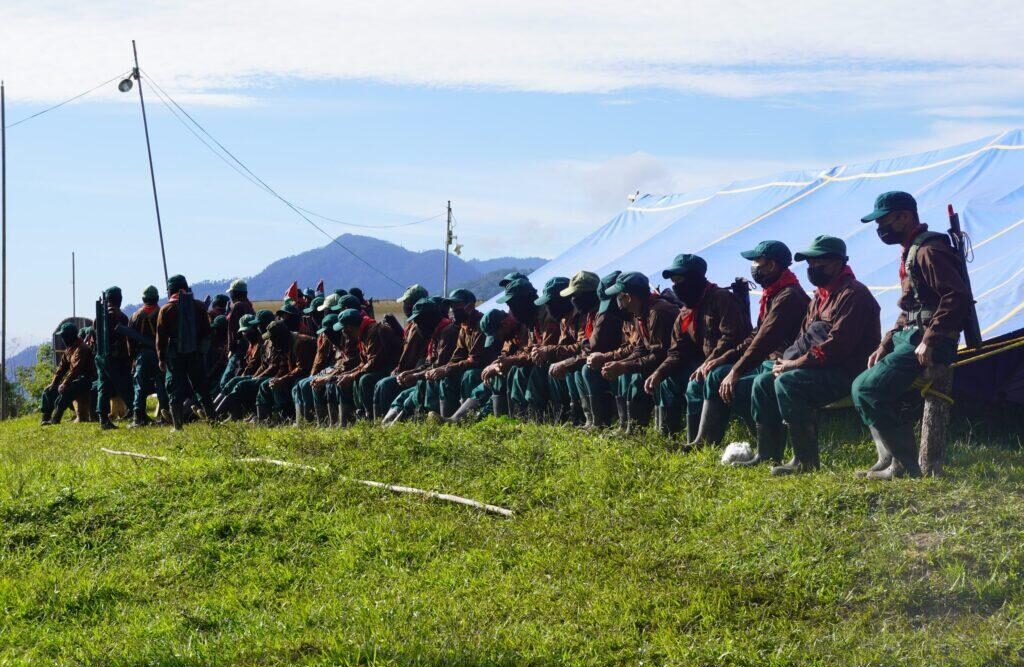
The Zapatistas did it again. What did they do? A little bit of everything, and a lot. They called on humanity to share some of the ways in which the struggle against capitalism continues and is sustained. On this occasion, they compared it to a pyramid, inviting us to question and tear down the pyramids that oppress us, that are sustained by repression, exploitation, contempt, and dispossession.
Their message was clear: “We don’t want a less evil government,” they said. They want a free and organized society that can face the apocalyptic challenges that capitalism has created. They call on us to resist the storm that is coming and the one that has already begun, which grows day by day, threatening all life.
For 14 days, we were invited to listen, to hear one other, and also to speak up with the aim of learning about the many ways in which honest hearts and small and large organizations resist and build alternatives, as they confront the capitalist hydra in their territories. More than 2,700 people from over 45 countries joined the Zapatista Caracol in Morelia. Zapatistas and movements from various parts of the world shared their dreams and hopes, but more importantly, the way in which they are building them “not only in words, but in deeds,” as the Zapatista autonomous communities reiterated in their initiative.

Many of these resistance movements informed us of the problems they face on their lands. The young Americans involved in the pro-Palestinian demonstrations that were heavily repressed by the Trump administration, the Kurdish resistance with Confederalism and the war they face on their lands invaded by nation states, anarchist unions such as the FUA in Germany reviving the original rebellious spirit of the workers’ struggle, the communities resisting repression in El Salvador and its prison policy, in Chile and Argentina, where there is a war against the Mapuche people, the work of squatters and their solidarity in Italy and Greece, the experiences of land recovered and worked collectively, in common, as the Zapatistas say, and how these struggles add to the fight against wars, racism, all forms of violence, patriarchal and even digital.
Solidarity with Palestine was at the heart of it all. In the words and actions of many, the central theme was the need to stop genocide, which is a common cause in the struggle against global capitalism. The Zapatistas, and mainly the militiamen, came out carrying Palestinian flags, and in their speeches, the Zapatista leadership insistently reminded everyone of the pending task of stopping the massacre being carried out by the State of Israel and the United States in occupied Palestine. Hundreds of activists from many different places came to the meeting, bringing with them the Palestinian cause as their agenda and banner. They included people who had gone to the humanitarian marches in Egypt, Pallasos (with a double L) who work with refugee camps, collectives who spoke of the large demonstrations in Europe, of ports closed to prevent more weapons from passing through, of those who have boarded ships to try to break the siege that sea, air, and land have imposed on a defenseless people.

The theme of self-criticism was a relevant topic in the Zapatista debate, like a dirty mirror that must be constantly reviewed and cleaned. In plays and arguments, they spoke of contradictions in the ways they have experienced self-government, and the result was that they realized that the system of oppression is constructed like a pyramid, and that if we repeat those pyramids, the abuses of power will be repeated. The models that were tried in the Good Government Councils did not work; there were abuses, bad practices, bureaucracy, and impositions, but this movement, which has been moving forward for a long time, decided to break with that model, of their own pyramid.
Now as Local Autonomous Governments, community assemblies and large working committees they are gaining strength, and in a reclaiming of the dreams they sought with the uprising and the blood that was shed in 1994, driven by their autonomous models of governance and the knowledge of the indigenous peoples, these mostly indigenous Mayans continue to surprise the world. Now they are promoting communalism, the common good, and the abolition of private property to liberate Mother Earth, a debate that refreshes the political imaginary. Against all odds, they have sustained themselves and blossomed for 31 years on the lands they wrested from their oppressors and the state. In this way, they continue to call for debate and the construction of these free worlds, with new or old dreams, but dreams of freedom nonetheless.
Another theme was “The Pyramid” or the critique of power and the State, a pyramid that is many pyramids, a comparison in order to criticize the hierarchical power relations in our societies. The Zapatista pyramid had four sides: repression, exploitation, contempt, and dispossession. In many of our communities and organizations, hierarchies of power and privilege are reproduced. A simple example is those who go to work for the state, those who fight to escape poverty in an individualistic way, coming from popular causes, seeking to repeat the pyramids, the hierarchies. They do not fight against the pyramid, they seek the top of that pyramid. Clara Brugada and Sheinbaum are examples of this, the former a university activist, the latter a housing organization leader. They just made a new pyramid with the same four sides, more and more like the old one. Once they got to the top, they became the new rich of the political class that narco-governs like puppets of global empires.
Pyramids as a symbol of a structured society with a few at the top who oppress and subjugate the many at the bottom of that pyramid. Not only in the structure of the state but in many social formations, pyramids that we have been accustomed to believing in and repeating, one pyramid (for example, the 4T) replacing another pyramid, with the justification of being “less bad” than the previous one, although with time and the great cynicism that characterizes the political class, they end up being a pyramid, just as unjust and unequal as any other at any other time. Thus, the Zapatistas criticized these pyramids, and in their historical account, they criticized the pyramids of the past, those of the Mexicas, the Mayans, and the current ones of bad governments, large and small, of the current nation-states.

The experience of their journey to rebellious Europe left its mark. The Zapatistas felt more connected to those peoples who responded with contingents of social activists from different parts of the world. With patience, utmost tolerance, and the greatest respect, the Zapatistas listened for 14 days to anyone who wanted to share their message. They shared their voice, their work, their time, their organization, their proposals, and their example. At nine in the morning, the activities began. The Zapatistas were already in their places to start the long days. They rotated and other peoples arrived to join the commissions, some to the work, others to the food, to the cleaning, to the listening. Thousands of Zapatistas organized themselves to maintain this global activity to confront capitalism. After almost twelve hours of discussion at 8:30pm, with only a break for lunch and pozol., the presentations would end. For fourteen days, the Zapatista representatives from each community, accompanied by the Zapatista leadership, listened patiently, attentively, and respectfully.
Theater and the arts are their tools for the massive construction of the future, and have been a constant feature of recent Zapatista gatherings. It is extremely valuable to learn about their work, analyze and understand their arguments, and the ways in which they express them aesthetically in many performances, music, poetry, and visual arts. On this occasion, they shared some plays, the first criticizing the bad practices that occurred in the Good Government Councils from a self-critical perspective of their own movement, another in which they hold an assembly with the dead, and another with the so-called “agüitas” (little waters) that simulate the eggs and sperm of future Zapatistas.
Among their contributions was the presentation of their proposals to save the future by rescuing the wisdom of the past, first with the work they have done in health by reviving the use of plants and natural treatments, then they showed us how to build a house without modern tools, as our grandparents did, without nails, without power tools, only the ingenuity of the communities in a way that respects nature. With a sugar mill, they taught us how to make panela and drink a delicious glass of sugarcane juice. They held a gastronomic exhibition with food from the communities, free of GMOs, healthy, tasty, and showing how generous Mother Earth is and the communities that care for her.
The Zapatistas invited us to share what we were doing to confront capitalism, not to give us recipes or words that were not backed up by concrete work. However, the recipes were everywhere for those who wanted to listen and see with their eyes and ears wide open.
We recommend checking out the Enlace Zapatista page and the coverage by the free media of the “Some Parts of the Whole” gathering. Long live autonomy and the overthrow of the pyramids that oppress us.
Original text and photos by Noticias de Abajo published on August 30th, 2025.
Translation by Schools for Chiapas.